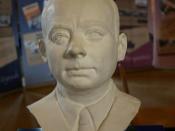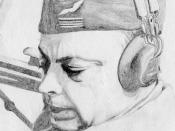People look at too many obvious and accepted places for moral guidance, including parents, teachers, and even the media. Maybe it is because readers frequently deduce morals from a book's story. Rather than having the morals directly presented, society forgets the impact books have on one's morality. It is important, however, to realize a book's moral implications, for they often leave a lasting impression on the mind of the reader. The Little Prince by Antoine de Saint-Exupery puts great examples of morality in literature well.
Through the use of simplistic language and style, vivid illustrations, and poetic descriptions and metaphors, Saint-Exupery created a masterful piece of literature that has affected the lives of many readers. The rich use of these literary techniques animates The Little Prince and makes the entertainment value and, indirectly, the values of the book immense. But although the book has a fairy tale-like quality, the reader must not overlook the realities, both harsh and subtle, that the book forces him/her to examine.
Saint-Exupery's simple language and style is apparent from the onset of the book--which begins with the pilot's autobiographical childhood story. In this story, the pilot reveals both a look at his inner self and a tremendous lesson. Using simple words and a basic, sequential story, the pilot describes how adults misperceived his drawing of a boa constrictor eating its prey to be a plain old hat. This story serves a couple purposes in the book's overall scheme and will reappear later. First, the pilot's story serves as a predecessor to the story which will follow. But secondly--and of greater significance--the pilot's story shows the tremendous importance of imagination in one's life. It is here the reader is told to look beyond the aesthetics of things; s/he must view everything abstractly and with an open mind. For it is when one looks with a sense of innocence and faith, as opposed to looking with reason and evidence as most adults do, that s/he is able to see the truth in something.
Saint-Exupery's illustrations are of key significance to the book, which often calls attention to a particular drawing. When we were children, drawing was a serious matter to us. We drew with intensity to make sure every detail was exact--not necessarily in a technical way, but in a perceived way. The pilot notes about drawing the little prince, "If I try to draw him here, it is to make sure that I shall not forget him. To forget a friend is sad. Not everyone has had a friend. And if I forget him, I may become like the grown-ups who are no longer interested in anything but figures." This statement shows the stress Saint-Exupery places upon drawing as a way to communicate to ourselves and others the way we perceive something on personal level, not just how it is seen with our eyes. The statement also contains two valuable moral lessons: the importance of friends and love in a person's life and the overemphasis people place on material and literal things.
Saint-Exupery draws from his own life experiences and adds to them a poetic flair to create vivid descriptions of the world and the significance of life. Three particular statements come to mind. First, by writing that humans only "occupy a small place upon the Earth," Saint-Exupery puts into perspective the fact that humans are not the center of the Earth and as all-important as we often believe we are.
Later, the snake states, "I can help you, some day, if you grow too homesick for your own planet," and little prince stops the snake from further explanation of this odd offer of assistance by innocently saying "Oh! I understand you very well . . . But why do you always speak in riddles?" Thus, Saint-Exupery exposes how well the innocent are able to see the truth in things.
Third, and perhaps of most importance to the story, the pilot states, "When I was a little boy I lived in an old house, and legend told us that a treasure was buried there. To be sure, no one had ever known how to find it; perhaps no one had ever even looked for it. But it cast an enchantment over that house. My home was hiding a secret in the depths of its heart." The metaphor here explains in a truly unique and vivid way a realization--that the very things that make something beautiful are not seen with one's eyes--that will lead the pilot (and also the reader) to uncovering the secret of everything in life.
However, to what extent is The Little Prince dominated by morality? Robertson Davies wonders "how far literature may be expected to discuss moral problems and what contributions it can make to their solution, whether being untrue to itself," and then asserts "virtually all novelists, playwrights, and poets of serious artistic purpose become inevitably involved in problems of morality, but such writers are on dangerous ground when they allow their work to be dominated by moral purpose." The Little Prince is no exception to either of Davies' statements. Though the story provides its readers with various sound morals, most people read the book for its youthfulness and charm. And, while The Little Prince does greatly focus on morality, it is Saint-Exupery's use of simplistic language and style, vivid illustrations, and fanciful poetic descriptions that save the story from the bleakness of simply being a morality lesson. Had Saint-Exupery totally avoided writing with underlying morals, however, The Little Prince would have lost many of the very moving and personalized experiences it invokes in its readers. But, by disguising the sophisticated morals in an air of innocence, wittiness, and light-heartedness, Saint-Exupery successfully balanced the heaviness of morality with heart-warming charm.




